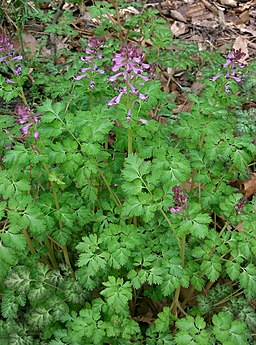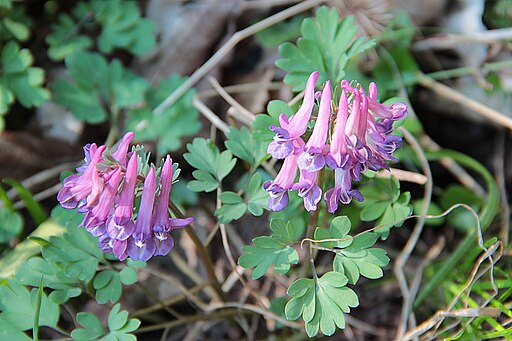Wanted! Incised Fumewort
Have you seen evergreen, parsley-like leaves on the forest floor? They may be the evergreen winter foliage of plants in the genus Corydalis. Only two species are known to occur in our area: one is native (Yellow or pale fumewort, Corydalis flavula) and the other invasive (Incised fumewort, Corydalis incisa). The alien was reviewed by USDA APHIS in 2017 and they concluded that this is a “high risk” invader, which means that it has both the potential to become widespread and the potential to cause a lot of damage.
These facts are from the APHIS assessment:
“As demonstrated by its status in the United States, C. incisa exhibits a strong ability to escape and spread. It is a shade-tolerant (Fleming, 2017; Glick, 2017b) annual/biennial (Zhang et al., 2008) that is self-compatible (Zhang et al., 2009) and has a high reproductive capacity (Nakanishi, 1994). Plants ballistically eject seeds out of the fruit pods up to three meters away (Nakanishi, 1994). Seeds can then be further dispersed by either ants (Andruk, 2017; Zhang et al., 2008) or water (Atha et al., 2016a). U.S. evidence indicates that plants are likely being dispersed as contaminants in nursery material (Maurer, 2017). Plants can form dense patches and seem tolerant to hand-pulling and clipping at certain stages of their life cycle [Atha et al., 2016a; Atha et al., 2014b; Andruk, Hudson, and Nolan, unpublished data (provided by Andruk, 2017)].”
How to Identify During Bloom:
Flowering begins in March, and at that time the species are easy to tell apart by flower color. The alien (Incised fumewort) is purple, and the native (Yellow or pale fumewort) is yellow. Plants produce mature seeds quickly, within two or three weeks of first bloom.

Commons Incised Fumewort (C. incisa) can grow 10-50cm tall and has purple flowers. Photograph of Corydalis incisa by KENPEI, CC BY-SA 3.0, via Wikimedia.

Yellow or Pale Fumewort (C. flavula) can grow 15-30cm tall and has yellow flowers. Photograph of Corydalis flavula by Fritz Flohr Reynolds, CC BY-SA 3.0, via Wikimedia.
How to Identify Before Bloom:
Flowers are not always present so it can be handy to know how to identify Corydalis species from just their leaves. This can be especially handy in winter because these species are evergreen! In winter, petioles emerge directly from the root crown. In the illustration below, we see two petioles, each holding one leaf. The petiole splits into thirds, each sub-petiole supporting a leaflet. Leaves that split into three parts are called ternate, and the most familiar example of a ternate leaf would be clover. In the illustration, the terminal leaflet is shaded. On top of that, each leaflet is divided into three sub-leaflets (dark green shading). In the alien species, some of these sub-leaflets are divided (all the way down to the vein) yet again. In the native species the sub-leaflets are lobed, sometimes deeply lobed, but not divided. The most reliable trick I can recommend for telling these two species apart (when flowers are absent) is to count the lobe tips on a sub-leaflet. The native species will have something like 5 to 7, and the alien will have two or three times that. Look at the illustration and count the tips on the sub-leaflets and see what numbers you come up with!

Line drawing of the two types of leaves by Sara Tangren, National Capital PRISM, CC BY.
Looking at a tangle of leaves on the woodland floor, or in an iNaturalist photo, the individual leaves can be hard to discern. The key to success is to isolate an individual leaf so that you can get a good look at its outline. Check out the observations by izafarr and sara_tangren. Can you confirm these identifications based on the photos?

Photograph of C. incisa leaves by izafaar, CC BY-NC, via iNaturalist.

Photograph of C. flavula leaves by sara_tangreen, CC BY-NC-SA, via iNaturalist.
There are also some qualitative differences between the two types of leaves, but unless you have them side by side, it’s hard to use qualitative differences for identification. For example, in winter, the alien leaves tend to be darker, but sometimes lighter toward the center, and they tend to have little white spots on them (glands perhaps?). These differences are useful but gradational, somewhat inconsistent from plant to plant, and fade as winter moves into spring.
Tips for making a good observation record of Corydalis:
Take photographs that show:
- the landscape around the plant – this shows the context and offers a clue to the scale of the infestation
- if they are flowering, show a whole plant including flowers and leaves
- if they aren’t flowering yet, show a whole, typical, undamaged leaf
Make comments that:
- are explicit about the issue of intentional plant vs weed vs escaped (this saves reviewers a few minutes checking for cues of cultivation in the photo and zooming in on the map)
- give a rough estimate of the number of patches and/or the area covered
- any other comments you think might be helpful
Similar Species:
Yet another purplish-flowered member of the poppy family has been detected in our area, Common fumitory (Fumaria officianalis), but it’s quite different looking. It tends toward somewhat sunnier habitats, is a taller plant, and stands weakly erect. It blooms later in spring to early summer. If you look closely at the leaves you’ll see the “family resemblance”.

Common fumitory (F. officianalis) can grow 10-50cm tall and has purple or crimson-tipped, pink flowers. The leaves are alternate, compound, and lobed. Photograph of Fumaria officinalis by Llez, CC BY-SA 3.0, via Wikimedia.
There is another purplish-flowered woodland Corydalis invading to our north, bird-in-a-busch (C. solida). As the name implies, the leaves are not so thoroughly divided. There’s a nice photo of it in its native range here. Although I have read that it is not expected to range this far south, I notice that the iNaturalist map shows reports all throughout Europe. Perhaps it would be best to keep an eye out!

Bird-in-a-bush (C. solida) can grow up to 25 cm and has blue-purple, pink-red, or purplish-red flowers. The leaves are alternate, compound, and lobed. Photograph of Corydalis solida by Jean-Pol GRANDMONT, CC BY-SA 3.0, via Wikimedia.
I suspect a few of you know more about the fumeworts than I do. I’d sure appreciate any corrections and additional insights. Happy hunting!






Comentarios
Spotted in DC in Rock Creek Park.
Agregar un comentario